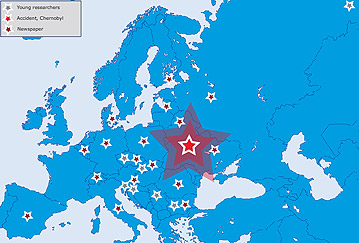On 26 April 1986 at 1:23 a.m., the worst accident in the history of civilian use of nuclear energy took place when a fire broke out in the overheated third reactor of the Chernobyl nuclear power plant.
Radioactive particles escaped from the exploded building, contaminating regions of Ukraine, Russia and Belarus. Other parts of Europe were affected to varying degrees. (Read more in the chronicle).
The Chernobyl accident caused a common feeling of insecurity and doubt across Europe.
The task: We looked for the first article about the catastrophe in a leading newspaper in our respective countries. There was no information until 29 April, when the Soviet news agency TASS reported on it. For some of us the task seemed very easy, as there was a big article on page one. For others, finding an article was quite difficult, especially since they were hidden somewhere on the last pages.
The results: Coverage in the Eastern Bloc can be characterized by two words: silence and censorship. While inhabitants of the “socialist paradise” were exposed to radiation, the authorities were busy preventing information on the accident from reaching the public. One comment clearly expressed people’s emotions: “It is unfair that there was no warning. Radioactive clouds don’t stop at the Iron Curtain.”
The first articles in Western Europe appeared on 29 April 1986 but the newspapers in question were not influenced by censorship; western journalists expressed not only simple facts from the TASS report, but also their personal opinions and political statements.
The authors of this introductory text are Tamara Cakic (Slovenia), Milena Tatalovic (Serbia), Vanya Tsvetkova (Bulgaria), Vojtech Pojar (Czech Republic) and Helena Ursic (Slovenia).

